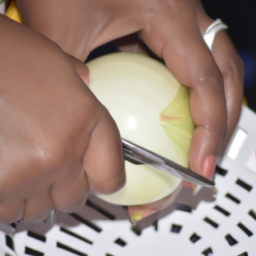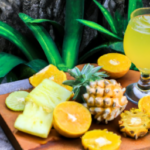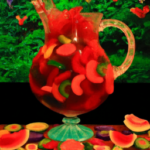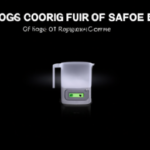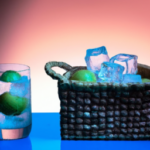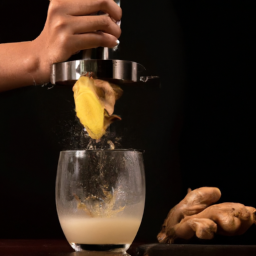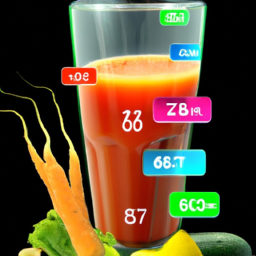As the adage states, “life is a jungle, so why not imbibe as such?”
Jungle juice is a classic party beverage that is loved by many for its fruity, sweet, and boozy taste. Whether you’re hosting a backyard barbecue, a college party, or just want to spice up your weekend, making jungle juice is an excellent way to get the party started.
In this article, I’ll guide you through the steps of making jungle juice, from choosing the right alcohol to serving it to your guests. We’ll explore different recipes and techniques to help you create your perfect blend.
So, put on your party hat and let’s get started on making the ultimate jungle juice that will have your guests raving about your hosting skills for days to come!
Key Takeaways
- Jungle juice is a popular party beverage with endless variations that can be made in a large batch with vodka, rum, tequila, boxed wine, or cheap beer.
- Adding fruits, juices, alternative sweeteners, carbonation, and infusion techniques like using a fruit or vegetable puree, steeping herbs and spices, or adding a tea bag can enhance the flavor of jungle juice.
- Preparation ahead of time, accurate measurement of ingredients, and ratio of 3:1 (juice to alcohol) are crucial when making jungle juice, which should be chilled ahead of time in a pitcher, punch bowl, frozen fruit, or large cooler.
- Safety is important when consuming jungle juice, as excessive drinking can lead to dangerous situations and alcohol poisoning, so having a designated driver or plan for transportation, storing and transporting jungle juice safely, and ensuring that guests have a safe way to get home after the party are necessary.
Understanding the Basics of Jungle Juice
Now, let’s dive into the nitty-gritty of jungle juice and understand its basic components. Jungle juice is a party staple, and it’s essential to know the basics of making it.
One of the best things about jungle juice is that there are endless variations. You can make it to fit any taste or party theme.
When making jungle juice, it’s important to keep in mind the serving suggestions. It’s best to make a large batch in a punch bowl or drink dispenser with a spigot for easy serving. You can also add fruit slices or garnishes to make it more visually appealing.
Now, when it comes to choosing the right alcohol for your jungle juice, it’s crucial to consider the type of party you’re hosting.
Choosing the Right Alcohol
You’ll want to think about the type of vibe you want to set for your party when selecting your alcohol. Choosing the right liquor can make or break your jungle juice. If you want to keep the party going all night, I suggest using a combination of spirits like vodka, rum, and tequila. These liquors have high alcohol content, which means you won’t need to add as much to your mix, and they’re versatile enough to mix well with any juice or fruit you add.
On the other hand, if you’re on a tight budget, there are budget-friendly alcohol options to consider. You can use boxed wine or cheap beer to stretch your dollar further, but keep in mind that they might not have the same depth of flavor as higher-end liquors. Ultimately, your choice of alcohol will affect the overall taste and potency of your jungle juice. So choose wisely, and remember to have fun experimenting with different combinations of liquor and juice flavors. Now, let’s move on to adding fruits and juices to your mix.
Adding Fruits and Juices
As I dive into creating my party punch, I like to get fruity with it by adding a variety of fresh squeezed juices and sliced up fruits to liven up my libation. I love experimenting with creative combinations like a mix of orange, pineapple, and cranberry juice with chunks of fresh strawberries and sliced lemons.
Not only does this make for a visually appealing drink, but it also adds a refreshing taste to my jungle juice. Adding fruits and juices not only enhances the flavor of your jungle juice, but it also brings health benefits to your guests. Fruits are packed with vitamins and antioxidants that can boost the immune system and improve overall health.
So, the next time you’re making jungle juice, don’t be afraid to get creative with your fruit and juice combinations and offer a healthy option for your guests. Now, onto sweetening your jungle juice with a touch of sweetness.
Sweetening Your Jungle Juice
Get ready to add a touch of sweetness to your wild party concoction by trying out some creative ways to sweeten your fruity jungle juice. To balance sweetness, it’s important to use alternative sweeteners like honey, agave, or stevia in moderation. These natural sweeteners not only add flavor, but also have health benefits that make your jungle juice a healthier option.
Another way to sweeten your jungle juice is by using fruit juices like apple or grape juice instead of sugar. These juices not only add sweetness, but also add a fruity flavor that blends well with the other ingredients. Remember to taste test as you go along to get the perfect balance of sweetness for your taste buds.
Now that your jungle juice is sweetened to perfection, it’s time to add some carbonation for an extra fizz.
Adding Carbonation
Now’s the time to give your punch some pizzazz with a burst of carbonation. Carbonation not only adds a fun fizz to your jungle juice, but it also enhances the overall taste and experience.
The benefits of carbonation are endless – it helps to cut through the sweetness of the juice, creating a balanced and refreshing beverage. Plus, the bubbles make it more exciting to drink and add a festive touch to any party.
If you’re looking for alternatives to carbonation, you can try adding some sparkling water or soda to your jungle juice. However, keep in mind that these options may alter the flavor of your punch and may not provide the same level of carbonation as traditional carbonated drinks.
Alternatively, you can also try adding some dry ice to your punch bowl for a dramatic, smoking effect. Just be sure to handle the dry ice with care and avoid direct contact with skin or mouth.
Now that your jungle juice is carbonated to perfection, it’s time to move on to the next step – infusing your punch with a kick of flavor.
Infusing Your Jungle Juice
Now that we’ve carbonated our jungle juice, let’s talk about infusion.
I love adding herbs and spices to my jungle juice to give it a unique and flavorful twist. Some popular infusion techniques include using a fruit or vegetable puree, steeping herbs and spices in the juice, or even adding a tea bag to the mix. Trust me, these small additions can take your jungle juice to the next level.
Adding Herbs and Spices
Don’t forget to sprinkle in some cinnamon and basil for an added depth of flavor to your jungle juice. These herbs not only add a delicious taste to your drink, but they also have numerous health benefits.
Cinnamon, for instance, has anti-inflammatory properties and can help regulate blood sugar levels. Basil, on the other hand, is rich in antioxidants and can aid in digestion.
When it comes to herbs and spices pairing, the options are endless. You can add a hint of mint for a refreshing taste, or throw in some ginger for a spicy kick. Whatever your preference may be, it’s important to remember that less is more. Start with a small amount and adjust according to your taste.
Now that we’ve added some delicious herbs and spices to our jungle juice, let’s move on to some popular infusion techniques.
Popular Infusion Techniques
To infuse your beverage with a burst of flavor, try adding fruits or herbs to your drink and let it sit for a few hours. There are many infusion variations you can experiment with, such as using a muddler to crush fruits like strawberries or blueberries before adding them to your drink.
You can also use infusion tools like a mesh strainer or cheesecloth to strain out any larger bits of fruit or herbs. Another popular technique is to create a simple syrup infused with herbs like mint or basil. Simply boil equal parts water and sugar until the sugar dissolves, then add your herbs and let it steep for a few hours.
You can also try using a fruit or herb-infused alcohol like vodka or rum to add an extra kick to your jungle juice. With these infusion tips, you can create a unique and flavorful jungle juice that will impress your guests.
Now, let’s move on to the next step of mixing and serving your jungle juice.
Mixing and Serving Your Jungle Juice
Once you’ve mixed all the ingredients together, it’s time to serve your delicious jungle juice to your guests! First, make sure you have a large enough container to hold all of the juice, preferably one with a spigot for easy pouring.
After that, add some ice to keep the juice cool and refreshing.
When it comes to serving, there are a few mixing techniques you can use to make sure the juice is evenly distributed. You can use a ladle to mix the juice, or simply give the container a gentle shake.
To make your jungle juice even more festive, consider adding some garnishing options such as sliced fruit or colorful straws. And with that, your jungle juice is ready to be enjoyed by all!
Now, if you’re making a large batch of jungle juice for a party, it’s important to remember to keep it chilled and stirred occasionally to keep the flavors evenly distributed.
So, let’s dive into the next step of making a large batch of jungle juice.
Making a Large Batch
When I’m making a large batch of jungle juice, there are a few things I always keep in mind. First, I need to calculate the right amount of alcohol, mixers, and fruit to ensure everyone gets a tasty drink without going overboard.
Second, I prepare ahead of time by buying all the necessary ingredients, cutting up the fruit, and chilling everything in the fridge.
Finally, I make sure to have plenty of ice on hand to keep the jungle juice nice and cold. With these tips, I can confidently make a delicious batch of jungle juice for any party or gathering.
Calculating the Right Amount
Calculating the right amount can be tricky, but you’ll want to aim for about 2 gallons of juice for every 10-15 people to ensure everyone can have a good time. To do this, calculating ratios is essential.
You don’t want to end up with too much or too little juice, so measuring ingredients accurately is crucial. Keep in mind that the amount of alcohol you add will affect the ratio of juice needed. Typically, a ratio of 3:1 (juice to alcohol) is a good starting point.
When it comes to measuring ingredients, it’s best to use a large container with clear markings to ensure accuracy. You can also use measuring cups and spoons, but this may take longer and be less efficient.
Remember to account for ice, which will take up space in the container and water down the mixture as it melts. Once you’ve calculated the right amount, you’ll be ready to move on to the next step: preparing ahead of time.
Tips for Preparing Ahead of Time
Now that we know how to calculate the right amount of ingredients for our jungle juice, it’s important to start thinking about preparing ahead of time. Making jungle juice can be a lot of work, so it’s best to plan ahead and make things as easy as possible. By doing this, we can enjoy the party with our guests and not be stuck in the kitchen all night.
To make things easier, I like to make my jungle juice ahead of time and chill it in the fridge. This not only saves time the day of the party, but it also allows the flavors to meld together, resulting in a better taste. There are a few different chilling options to consider. One option is to simply chill the juice in a large pitcher or punch bowl. Another option is to freeze some of the fruit and use it as ice cubes in the juice. This not only chills the juice but also adds a fun and unique touch to the drink. Lastly, if you have access to a large cooler, you can fill it with ice and place the pitcher or punch bowl inside to keep it chilled throughout the party.
With our jungle juice already prepared and chilling, we can focus on other party preparations and enjoy the festivities. But before we move on to the next section, let’s not forget about customizing our jungle juice to make it truly unique and special.
Customizing Your Jungle Juice
To truly make your jungle juice unique, you should experiment with different fruit combinations and alcohol ratios. One popular combination is using a mix of citrus fruits such as oranges, lemons, and limes, along with tropical fruits like pineapples, mangoes, and passion fruit. You can also add in berries like strawberries, blueberries, and raspberries for a sweet and tart flavor.
When it comes to alcohol ratios, some prefer a stronger punch while others may want a milder taste. Be sure to taste test as you go and adjust accordingly. Experimenting with ingredients is key to creating a delicious and personalized jungle juice. Don’t be afraid to get creative with your combinations and try new things.
However, it’s important to also keep safety in mind while making your jungle juice. Be sure to follow proper measurements and dilute with non-alcoholic mixers such as juice or soda. Stay tuned for some safety tips and precautions to keep in mind when making your jungle juice.
Safety Tips and Precautions
When it comes to jungle juice, it’s important to not only have fun, but to also drink responsibly.
To ensure safety, it’s crucial to store and transport your jungle juice properly.
As someone who’s experienced the dangers of drinking irresponsibly, I’ve learned firsthand the importance of taking precautions when it comes to jungle juice.
Drinking Responsibly
Remember, it’s important to always drink responsibly when making and consuming jungle juice. While it can be tempting to turn your jungle juice party into a wild drinking game, it’s important to keep in mind that excessive drinking can lead to dangerous situations and even alcohol poisoning. Make sure to pace yourself and drink plenty of water in between servings to avoid getting too drunk too quickly.
Additionally, always have a designated driver or plan for transportation ahead of time. Never drink and drive, and make sure your guests have a safe way to get home after the party. By taking these precautions, you can ensure that your jungle juice party is both fun and safe for everyone involved.
As you move on to storing and transporting your jungle juice safely, keep in mind the importance of responsible drinking.
Storing and Transporting Your Jungle Juice Safely
Safely transporting and storing your boozy concoction is crucial for avoiding any potential accidents or spills, ensuring that your party stays safe and enjoyable.
When it comes to jungle juice containers, you have several options to choose from. One popular choice is a large, clear plastic container with a tight-fitting lid. This way, you can easily see how much juice is left and ensure that the lid is secure before transporting it.
Another option is to use individual water bottles or mason jars for each serving, which makes it easy for guests to grab and go while minimizing the risk of spills.
When transporting jungle juice, it’s important to secure the container in a way that prevents it from tipping over or sliding around. If you’re driving, make sure the container is placed in a secure spot in the trunk or on the floor of the car. Avoid placing it on the seats or in the passenger area, as sudden stops or turns could cause it to spill.
If you’re taking public transportation or walking, consider using a sturdy backpack or cooler with ice packs to keep the juice cold and secure.
With these tips, you can safely transport and store your jungle juice and ensure that your party’s a hit!
Frequently Asked Questions
Can I make a non-alcoholic version of jungle juice?
Yes, I can make a non-alcoholic version of jungle juice by using non-alcoholic alternatives like sparkling water or juice. I can also add creative mix-ins such as sliced fruits, herbs, and spices for a flavorful and refreshing drink.
Can I use frozen fruits instead of fresh ones?
Frozen fruits can be used in jungle juice, but fresh fruits offer better taste and nutritional benefits. Thaw frozen fruits before adding them to the mix. It’s worth the extra effort for a delicious and healthy drink.
How long can I store jungle juice in the fridge?
I store jungle juice in the fridge for up to 2 days. Jungle juice storage tips include keeping it in a sealed container, away from strong odors, and checking for any signs of spoilage or off flavors. To tell if jungle juice has gone bad, look for mold, a sour smell, or a cloudy appearance.
What kind of container is best for serving jungle juice?
Glass pitchers are the best for serving jungle juice at an outdoor party or backyard BBQ. They allow for easy pouring and display the colorful drink beautifully. Punch bowls work well too, but can be more difficult to transport.
Can I add energy drinks to my jungle juice?
Adding energy drinks to jungle juice can provide a boost and enhance the party vibe, but it can also lead to overconsumption and potential health risks. The energy drink flavor can overpower the jungle juice, so use caution and consider other mixers.
Conclusion
Well, that’s how I make my jungle juice! It’s always a hit at parties and gatherings, and I love how customizable it is.
You can switch up the fruits and juices to suit your tastes, and even add in some carbonation for a little extra fizz. Just make sure to follow the safety tips and precautions, especially when it comes to monitoring alcohol consumption and staying hydrated.
In the end, making jungle juice is all about having fun and experimenting with different flavors and combinations. So go ahead and give it a try at your next event – who knows, it might just become your go-to party drink.
Cheers!
Ilana has been a vegan for over 10 years. She originally made the switch for health reasons, but soon found herself becoming more and more passionate about the ethical and environmental implications of a vegan lifestyle. Ilana is the author of The Graceful Kitchen, a blog all about veganism. She loves to cook up delicious and nutritious vegan meals, and share her recipes with others who are interested in leading a cruelty-free life. Ilana is also a strong advocate for using whole foods as the foundation of a healthy diet, and believes that going vegan is one of the best ways to achieve this.

